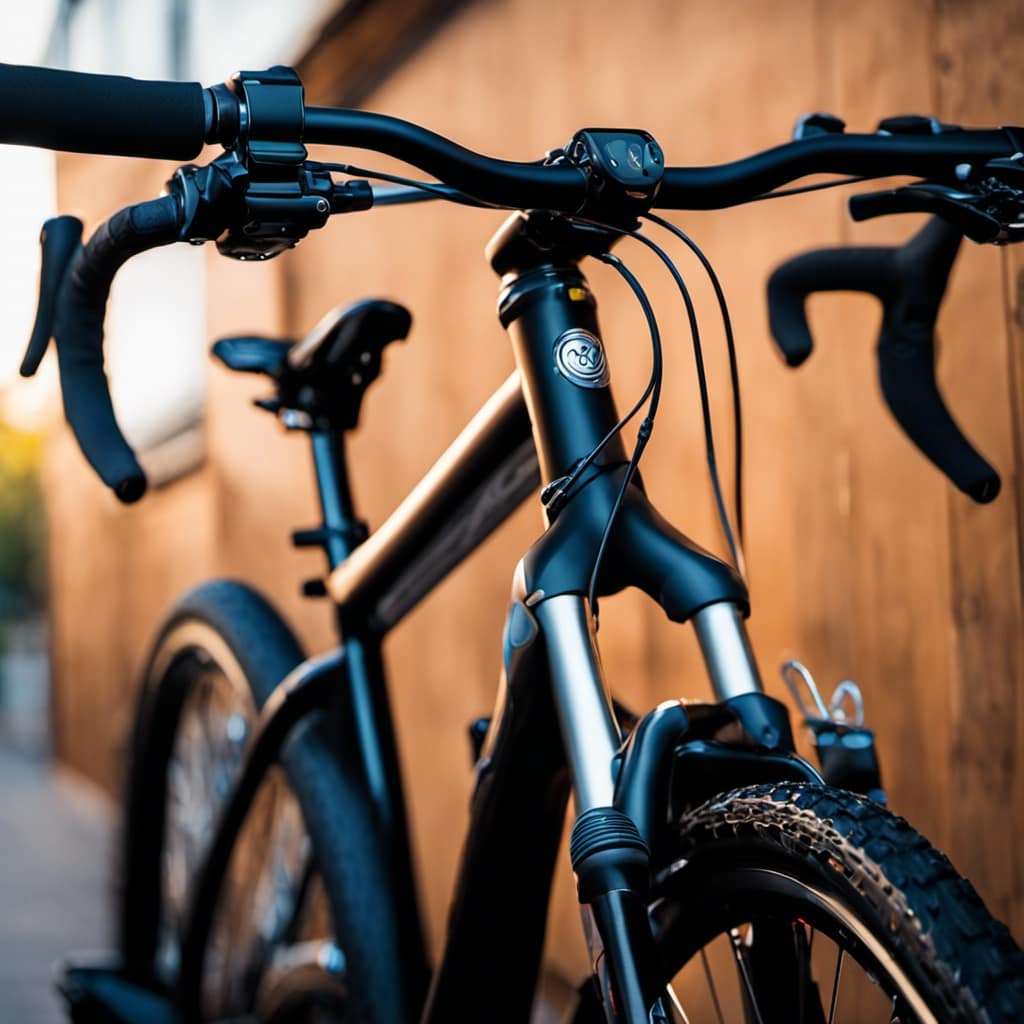Are you looking to amp up your fitness routine? Look no further! We’ve got you covered with 10 awesome exercises you can do with hybrid bikes.
Whether you’re into interval training, long distance rides, or hill climbs, we’ve got something for everyone.
Get ready to push your limits, improve your strength and endurance, and have a blast while doing it.
Get on your bike and let’s get moving together!
Key Takeaways
- Interval training on hybrid bikes enhances cardiovascular endurance and burns more calories.
- Incorporating strength training exercises improves overall performance and prevents injuries.
- Endurance training on hybrid bikes improves cardiovascular fitness and stamina.
- Cross-training with hybrid bikes targets different muscle groups, improves endurance, and prevents overuse injuries.
Interval Training
We can enhance our cardiovascular endurance and burn more calories by incorporating interval training into our hybrid bike workouts. High intensity workouts, such as Tabata training, are a great way to push our bodies to the limit and achieve maximum results. Interval training involves alternating between periods of high-intensity exercise and rest or low-intensity exercise.
This type of training not only increases our heart rate and cardiovascular fitness, but it also helps to improve our stamina and overall performance. By challenging ourselves with short bursts of intense activity followed by periods of recovery, we can efficiently burn calories and build lean muscle. Interval training is a fantastic way to mix up our workouts and keep our bodies guessing.
Now, let’s move on to the next section about long distance rides.
Long Distance Rides
For our long distance rides, we can choose scenic routes and explore new areas while enjoying the benefits of riding our hybrid bikes. Long distance cycling routes provide an excellent opportunity to challenge ourselves physically and mentally while discovering beautiful landscapes.
To ensure a successful and enjoyable ride, proper nutrition is crucial. Fueling our bodies with the right nutrients before, during, and after our long rides is essential for maintaining energy levels and promoting recovery. Foods rich in carbohydrates, such as whole grains, fruits, and vegetables, provide sustained energy for the duration of the ride. Hydration is also key, so it’s important to drink plenty of water and electrolyte-rich fluids throughout the journey.
Hill Climbs
Sometimes, we challenge ourselves with hill climbs on our hybrid bikes to push our limits and improve our strength and endurance. Hill climbs are an excellent way to build leg muscles and cardiovascular fitness. Here are some ways to make the most out of your hill climbs:
-
Hill Sprints: Incorporate short bursts of high-intensity effort while climbing. This will help increase your speed and explosive power.
-
Hill Intervals: Alternate between periods of intense climbing and recovery. This will improve your aerobic capacity and endurance.
-
Focus on Technique: Maintain a steady cadence and use your gears efficiently to tackle steep inclines.
-
Gradually Increase Difficulty: Start with smaller hills and gradually progress to steeper ones as your fitness improves.
-
Track Your Progress: Keep a record of your hill climbs to monitor your improvement over time.
Speed Drills
The speed drills on our hybrid bikes are exhilarating and help improve our overall cycling performance. Incorporating speed sprints and agility drills into our training regimen allows us to push our limits and become faster, more agile cyclists.
Speed sprints are short bursts of intense pedaling, where we push ourselves to achieve maximum speed in a short amount of time. These drills not only improve our cardiovascular fitness, but also enhance our leg strength and power.
Agility drills, on the other hand, focus on our ability to maneuver our bike quickly and effectively through various obstacles. By practicing quick turns, tight cornering, and rapid changes in direction, we develop the skills necessary to navigate challenging terrain with ease.
Engaging in these speed drills not only provides an adrenaline rush, but also helps us become more confident and capable riders.
Recovery Rides
After completing intense speed drills, we enjoy engaging in recovery rides to help our muscles recover and prevent injury. Recovery rides are an important part of our training regimen because they provide numerous benefits for our bodies. Here are some tips for effective recovery rides:
-
Keep the intensity low: Recovery rides should be done at a relaxed pace to allow our muscles to recover without adding additional stress.
-
Focus on active recovery: Instead of completely resting, recovery rides involve light pedaling to increase blood flow and flush out any metabolic waste.
-
Choose a flat route: Riding on a flat terrain reduces the strain on our muscles and allows for a gentle workout.
-
Listen to your body: Pay attention to how you feel during the recovery ride and adjust the intensity accordingly. If you feel any pain or discomfort, it’s important to slow down or stop.
-
Stay hydrated and fuel properly: Even though recovery rides aren’t as intense, it’s still important to stay hydrated and nourish our bodies with proper nutrition.
By incorporating recovery rides into our routine, we can enhance our overall performance and be better prepared for our next training session.
Now, let’s delve into the next section about ‘strength workouts’.
Strength Workouts
We love incorporating strength workouts into our hybrid bike routines to build muscular endurance and power. Strength training is essential for improving overall performance and preventing injuries. By engaging in weightlifting techniques, such as squats, lunges, and deadlifts, we can target specific muscle groups and enhance our cycling abilities.
These exercises not only strengthen our legs but also improve core stability and upper body strength, contributing to better control and balance on the bike. Incorporating strength workouts into our hybrid bike routine allows us to build the necessary strength to tackle challenging terrains and conquer steep hills with ease.
Now, let’s transition into the next section and explore the benefits of endurance training for hybrid bike enthusiasts.
Endurance Training
As we transition into endurance training, it’s important to focus on building our cardiovascular stamina and improving our overall cycling endurance. Here are some awesome exercises you can engage in with hybrid bikes to achieve high-intensity cardio workouts:
-
Interval Training: Alternate between periods of high-intensity pedaling and recovery periods of lower intensity. This helps improve our cardiovascular fitness and endurance.
-
Hill Climbing: Find a challenging incline and push yourself to conquer it. This will strengthen your leg muscles and increase your stamina.
-
Long Distance Rides: Go for longer rides to build endurance and improve your cardiovascular capacity.
-
Tempo Riding: Maintain a steady, challenging pace for an extended period. This will train your body to sustain effort over time.
-
Group Rides: Join a cycling group or club to challenge yourself and benefit from the motivation and camaraderie of fellow cyclists.
Cycling Races
Cycling races are a popular form of competition among cyclists of all levels. From local races to international events, there are plenty of opportunities to test your skills and push yourself to new limits.
In order to excel in cycling races, it’s essential to undergo proper training that focuses on improving speed, endurance, and technique.
Popular Cycling Races
Let’s explore some of the most popular cycling races around the world. Here are some famous cycling races that attract both professional cyclists and enthusiasts alike:
- Tour de France: Known as the most prestigious race, it covers over 2,000 miles and lasts for three weeks.
- Giro d’Italia: This Italian race is known for its challenging mountain stages and stunning scenery.
- Vuelta a España: Spanning 21 stages, this race showcases the diverse landscapes of Spain.
- Paris-Roubaix: Famous for its cobblestone sections, this race is often referred to as the ‘Hell of the North.’
- Tour of Flanders: With its cobbled climbs and unpredictable weather, this race is a true test of endurance and skill.
These cycling races require not only physical strength but also strategic planning and tactics. Mastering cycling race strategies is crucial for success.
Now, let’s transition into the next section and discuss how to train for these races.
Training for Races
Our team’s training for cycling races involves a combination of interval workouts, hill repeats, and long endurance rides. These exercises are essential for preparing ourselves for the challenges of race day.
Interval workouts help improve our speed and power, while hill repeats build our strength and endurance. Long endurance rides allow us to build up our stamina and test our mental and physical limits.
In addition to these workouts, nutrition plays a crucial role in race training. We focus on fueling our bodies with the right balance of carbohydrates, protein, and healthy fats to support our training and recovery. Proper hydration is also key to ensure optimal performance.
Cross Training
Cross training is a crucial aspect of any fitness routine. When it comes to hybrid bikes, there are numerous benefits to incorporating it into your workouts. By engaging in a variety of exercises, you can target different muscle groups, improve endurance, and prevent overuse injuries.
Some of the best cross-training exercises to complement your hybrid bike workouts include strength training, yoga, and swimming. These activities provide a well-rounded approach to fitness and can help you improve your overall performance on the bike.
Strength training helps build muscle and increase power, which can enhance your cycling abilities. Yoga, on the other hand, improves flexibility, balance, and core strength, all of which are important for maintaining proper form while riding. Lastly, swimming is a low-impact exercise that provides a cardiovascular workout while also giving your muscles a break from the repetitive motion of cycling.
Incorporating these cross-training exercises into your routine can help you become a stronger, more well-rounded cyclist. It also adds variety to your workouts, making them more enjoyable and reducing the risk of burnout. So don’t limit yourself to just biking – try incorporating these other exercises into your fitness routine for optimal results.
Benefits of Cross-Training
We love the diverse advantages of cross-training with hybrid bikes. Cross-training not only helps prevent injuries but also improves overall fitness.
Here are some benefits of incorporating cross-training into your exercise routine:
-
Variety: Cross-training with hybrid bikes allows you to engage in different types of workouts, keeping your exercise routine interesting and enjoyable.
-
Full-body workout: Hybrid bikes engage multiple muscle groups, providing a comprehensive workout for your legs, core, and upper body.
-
Low impact: Cycling on a hybrid bike puts less stress on your joints compared to high-impact activities like running, reducing the risk of injury.
-
Cardiovascular endurance: Regular cross-training on hybrid bikes can improve your cardiovascular fitness, increasing your endurance and stamina.
-
Weight management: Cross-training with hybrid bikes is an effective way to burn calories and maintain a healthy weight.
Incorporating cross-training with hybrid bikes into your fitness routine can help you stay injury-free while improving your overall fitness levels. Enjoy the benefits of this liberating exercise!
Best Cross-Training Exercises
Engaging in various cross-training exercises with hybrid bikes can greatly enhance our overall fitness levels. Not only do these exercises provide a cardiovascular workout, but they also target specific muscle groups, helping to improve strength and endurance. Two highly effective types of cross-training exercises that can be done with a hybrid bike are core strengthening exercises and plyometric exercises.
Core strengthening exercises focus on the muscles in the abdomen, lower back, and pelvis, which are essential for stability and balance. These exercises can be performed on a stable surface or on the bike itself, such as seated or standing cycling with resistance. Examples of core strengthening exercises include planks, Russian twists, and bicycle crunches.
Plyometric exercises, on the other hand, involve explosive movements that improve power and agility. These exercises can be done both on and off the bike, such as squat jumps, box jumps, and lateral hops. They help to increase muscle strength and coordination, making them ideal for cross-training with hybrid bikes.
Here is a table that showcases some of the best cross-training exercises with hybrid bikes:
| Exercise Type | Exercise Name |
|---|---|
| Core Strengthening | Planks |
| Core Strengthening | Russian Twists |
| Core Strengthening | Bicycle Crunches |
| Plyometric | Squat Jumps |
| Plyometric | Box Jumps |
| Plyometric | Lateral Hops |
Conclusion
In conclusion, engaging in the various exercises mentioned above with hybrid bikes is like embarking on a journey of self-discovery and transformation. Each exercise represents a different aspect of our physical and mental capabilities, pushing us to new heights and unlocking our true potential.
Just as the hybrid bike combines the best of both worlds, these exercises combine strength, endurance, and speed to create a holistic fitness experience.
So hop on your hybrid bike and let it take you on an incredible journey to become the best version of yourself.
















